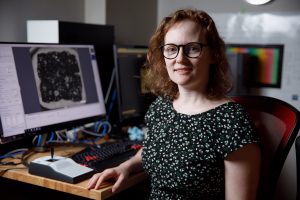 By examining meteorites, research led by The University of Alabama is tackling some of the biggest questions of our solar system, chiefly how the make-up of the inner planets formed.
By examining meteorites, research led by The University of Alabama is tackling some of the biggest questions of our solar system, chiefly how the make-up of the inner planets formed.
“We’re dealing with these tiny rock fragments that are so small, yet we are able to learn so much about how the planets came to be,” said Dr. Julia A. Cartwright, UA assistant professor of geological sciences.
Cartwright is leading a three-year, more than $400,000 grant from NASA to test whether meteorites from the asteroid belt reveal more about the activity of the solar system billions of years ago when asteroids and fragments of partially formed planets were shelling the inner planets, distributing metals and materials to their surfaces.
“Understanding impacts and the timing of those major events is important for understanding how surfaces came to be as they are,” Cartwright said.
Cartwright has a bank of meteorites in her lab from Vesta, which, unlike other bodies in the asteroid belt, has a structure with different layers made up of different materials, similar to Earth. She hopes subjecting these differing asteroid fragments to chemical analysis methods to determine composition and timings will show if Vesta experienced a similar bombardment as the moon or if it differed.
“Being able to see these different snapshots of solar system formation by looking at meteorites in the laboratory is incredible. This can be really useful with helping us to understand how our planet formed,” Cartwright said.
On this project, Cartwright and her students will collaborate with researchers at Arizona State University and the Swedish Museum of Natural History.
Learn more about the project by reading the full article on the UA News site.